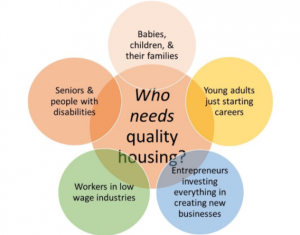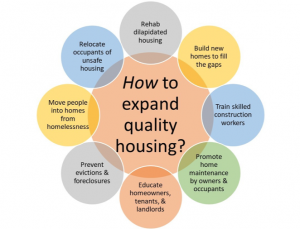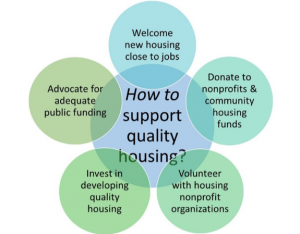
High medical costs, short-staffed businesses, low-performing schools, crime and vacant houses, homelessness, frustrations and injustices. An adequate supply of good places to live is not a magic wand but it would go a long way to improving health and stability. The persistent shortage of safe affordable housing consigns people to living in places that pose health risks and to moving frequently in desperate search for better options, resulting in deteriorating houses and transient neighborhoods. Living conditions spiral downward into a deep pit that is almost impossible to get out of. But imagine the difference when people don’t have to worry about leaking roofs and high rents and can focus on their health and families and jobs, on school work and active participation in their communities.

Who needs quality housing? Everyone. But especially think about people who have fewer resources, for whom housing problems can be life-threatening. Babies—our youngest community members—are too often homeless because child care, food, and other necessities plus rent are more than parents with entry-level jobs can afford. By school age, children have had too little stability to be ready to learn. Our first jobs are likely to be unpredictable hours at minimum wage; indeed, much of our working years may be in low wage industries that are essential to the economy. Or if we start a business, until the income is much more than the outgo, there isn’t much left for living expenses. And when we are no longer able to work, because of disability or age, we need the security of a home without steps so we can get in and out safely.

OK, so what does it take to have quality housing in our communities? The bricks-and-mortar work to expand the supply and the housing programs to assure stability are mutually dependent.
- Restoring housing in dangerous condition brings it back into the supply of quality homes. Hundreds of houses and apartments have been condemned and are waiting for the owners to repair or to sell to someone else to rehab. Purchase/rehab is complicated and challenging work but revitalizes neighborhoods as well as preserving places to live.
- We must build new housing close to jobs, of the size and design and price-point to fill the gaps; for example, while many households are one or two people, there are few one–bedroom units. Finding wheelchair accessible homes or housing for very large families is nearly impossible.
- There is a shortage of skilled construction workers, so train people to build new homes and repair old ones and support their families.
- Promote home maintenance through “carrots and sticks” (repair incentives and effective code enforcement) so that homeowners and landlords do not let housing fall below safe standards.
- Homeowners, rental owners, and tenants all need to know their responsibilities—and their rights.
- Housing counseling, case management, and legal services stabilize households facing housing loss; eviction and foreclosure are traumatic for health and expensive for rental owners, mortgage lenders, and community resources. The trauma and dislocation and credit impact of eviction and foreclosure usually result in worse and worse options for housing.
- People living in hazardous situations or experiencing homelessness on the street need help finding quality housing—since it is in such short supply—and usually need financial assistance with deposits and supportive services, such as case management and mental health care. Without this support, health deteriorates.

These are big challenges, with many moving parts. What can each of us, as individuals and small groups, do to make even the smallest difference? In our local communities, we can join with the organizations working on each part of the whole picture. We can consider the employees in the businesses near our neighborhoods and join with neighbors to encourage development of homes affordable to the workers, where they won’t need to take 3 buses to get to work. We can give money—and time and skills—to nonprofit organizations working on any aspect of quality housing. As we review our investments, we can search for opportunities in quality housing. And we can all tell our elected officials that for healthy stable communities, we need quality housing to be high priority for funding and for effective policies for land use and code enforcement. We can do it!
Beth – a wonderful analysis about how quality, safe, affordable housing can create many positive ripple effects (your first diagram). For your work on community engagement, have the Greensboro stakeholders who focus on health, schools, economic development/jobs bought into the focus on housing as a key – or THE key – component of what they want to accomplish?
I’m glad you focus on what individuals and small groups can do. I’m interested in the next layer up: building community coalitions. Sometimes groups trying to work together keep adding goals and objectives until the overall change agenda seems too big to be accomplished. What is your experience, please?
Clearly, we need community coalitions. Individuals working alone can rarely make sufficient impact; small groups working earnestly in siloes may duplicate efforts and waste resources competing. In Greensboro, effective coalitions are emerging, with complementary goals and enough overlapping participants to connect them without stretching agendas beyond the point of action. Some examples: InvestHealth is a team of City of Greensboro staff, UNCG’s Center for Housing and Community Studies, Cone Health, East Greensboro Now, and Greensboro Housing Coalition to bring together investment dollars and developers to purchase and rehabilitate distressed properties to reduce asthma hospitalizations. Collaborative Cottage Grove is a partnership of Cottage Grove Neighborhood Association, Mustard Seed Community Health, New Hope Community Development Group, and Greensboro Housing Coalition for community-centered health. BUILD Health Challenge partners Greensboro Housing Coalition, Cone Health, Guilford County public health, the City of Greensboro, and neighborhood associations to revitalize healthy communities. Ready for School, Ready for Life is a collaboration of organizations addressing the barriers for pre-natal and early child development so that all children can start school ready to thrive. Across North Carolina, people can find—or create—the coalitions with the depth and breadth to support quality housing in their communities.